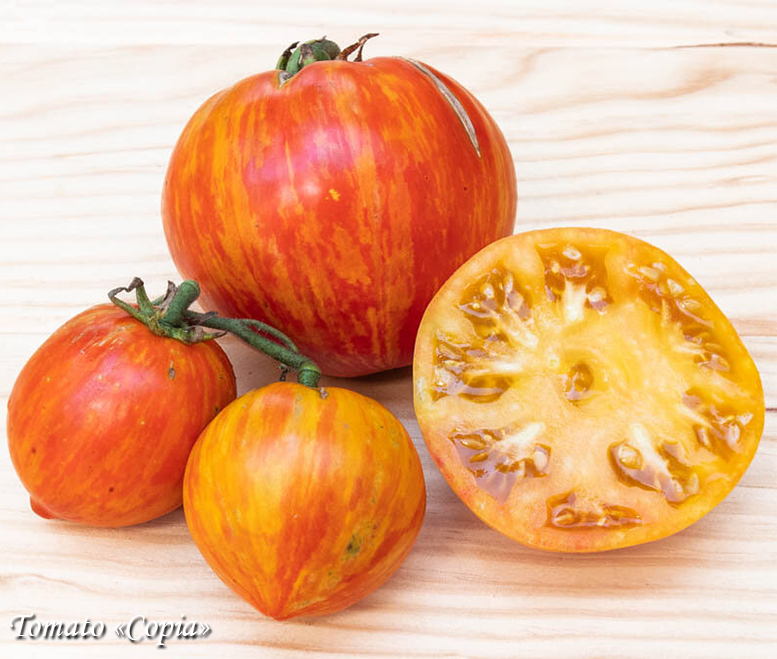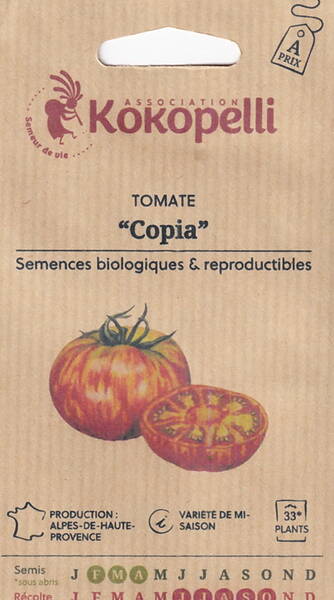Ex Tax: 2.94€
A mid-season, tall variety (200 cm).
This variety, a cross between "Marvel Striped" and "Green Zebra" produces large, fleshy fruits with golden-red stripes.
The fruits weigh from 150 to 300 g and are sweet and juicy. As they ripen, the golden stripes will become more numerous and brighter and more contrasting.
Agricultural Techniques.
Soil: tomatoes thrive in light, fertile soils.
Sowing: sow seeds for seedlings in March, 2-3 cm deep. Before sowing, treat the seeds with a potassium permanganate solution and rinse with clean water.
Seedling Care: prick out seedlings when the first true leaves appear. Apply a complete fertilizer 2-3 times during this stage. Begin hardening off the seedlings 7-10 days before transplanting.
Transplanting: transplant 60-65-day-old seedlings into heated greenhouses in April or into unheated plastic greenhouses in May.
Planting density:
* Determinate varieties: 5-7 plants per m².
* Indeterminate varieties: 2-4 plants per m².
Plant Formation: for tall (indeterminate) varieties, form plants into two stems. Use the shoot below the first flower cluster to create the second stem. Remove all other side shoots (suckers) and the lower leaves. To control growth, limit the plant to 6-8 fruit clusters. Staking tall tomatoes to horizontal or vertical trellises is essential.
Watering: water plants regularly using warm water.
Fertilization: apply 2-3 supplemental feedings during the growing season.
Improving Fruit Set: to enhance fruit set during flowering, gently shake the plants every 5 days or periodically use a fruit-setting stimulant.

* "Home Remedies" for Treating Tomato Blight:
-
Whey
-
Onion Husk Infusion
-
Propolis Tincture
-
Wood Ash Extract
-
Yeast Infusion (100 g per 10 liters of water)
-
Baking Soda
-
Dandelion Infusion
-
Rotten Hay Infusion...
This list can be continued, and all these remedies not only protect against parasites but also serve as a whole "storage room" of micro and macro elements (you can spray almost every day – it will provide the plants with both foliar feeding and disease treatment!).
* Folk Recipes for Combating Late Blight:
-
Garlic Spray: Grind 100 g of garlic (cloves, scapes, leaves) using a meat grinder, pour a glass of water over it, and let it steep for 24 hours. Then strain, dilute in 10 liters of water, and add 1.0 g of potassium permanganate. Treat plants every 10-15 days.
-
Whey Solution: Dilute whey from sour milk with water in equal parts. Starting from the first days of July, spray tomatoes with milk whey as often as every day.
-
Rotten Hay Infusion: Pour 10 liters of water over 1 kg of rotten hay or straw, add a handful of urea, and let it steep for 3-4 days. Spray the tomatoes with the strained infusion every week and a half to two weeks.
-
Iodine-Milk Solution: Dissolve 1 liter of skim milk in 10 liters of water and add 15 drops of iodine. Spray tomatoes with this solution once every two weeks.
-
Saline Solution: Dissolve 1 cup of salt in 10 liters of water and spray the large but still green fruits with this solution once a month.
-
Copper Sulfate Treatment: Take 2 tablespoons of copper sulfate for 10 liters of water and treat the plants once before flowering.
-
Yeast Treatment: Dilute 100 g of yeast in 10 liters of water and water the tomatoes.
* How to Combat Late Blight on Tomatoes?
Late blight is a fungal disease that occurs due to waterlogged soil and lack of sunlight. From the soil, the blight infects tomatoes, potatoes, and other garden plants.
Gardeners, wise from the bitter experience of fighting late blight, have drawn interesting conclusions:
-
Tomatoes planted in the ground at the earliest possible dates are significantly less affected by late blight than later varieties.
-
The same applies to tall (indeterminate) varieties: they are more resistant to blight than ordinary ones.
-
Tomatoes must be placed in well-ventilated areas.
-
The planting density of tomato seedlings should be minimal (within reasonable limits, of course). The main thing is that the leaves of adjacent bushes do not touch.
-
We prune the lower leaves; otherwise, it's a sure path to late blight.
-
Tomatoes must be watered only at the base. (As the folk saying goes: "Tomatoes should have wet feet and a dry head.").
-
Be sure to tie up the bushes: the fruits must not lie on the wet ground!
Always remember and "not tempt fate": late blight, to varying degrees (depending on the weather), has always been, is, and will be, and we must be constantly prepared for it.
The first symptoms of the disease appear where moisture persists the longest – on the lower leaves. It is necessary to inspect all bushes daily and take protective measures...
The most effective method of combating late blight, which has received not only an international patent but also the gratitude of gardeners, is, of course, FITOSPORIN!












